Authentic Kung Pao Chicken
This post contains affiliate links.
Kung Pao Chicken is a popular Sichuan chicken stir-fry that’s quick and easy to make on any given weeknight and full of irresistible savory, spicy, numbing flavors with a hint of tang and crunchy peanuts. Learn how to make it at home the authentic Chengdu-style way!
Today friends, I am super excited to be bringing to you an Authentic Kung Pao Chicken recipe!
First off, this is not your typical Panda Express kung pao chicken with the addition of bell peppers and zucchini. Nor is it the westernized takeout-style dish with an oversweet sauce made with hoisin sauce, oyster sauce, or honey.
While I do already have a kung pao chicken recipe on the blog that is incredibly tasty and shines in its own light, it isn’t 100% authentic due to the additional of a Sichuan spicy fermented bean paste. This version however, is based on the way one of my favorite traditional Sichuan restaurants in Hong Kong makes kung pao chicken. It also takes cues from Fuchsia Dunlop’s recipe from The Food of Sichuan and J. Kenji López-Alt’s recipe on Serious Eats for this iconic Sichuan dish.
After years of enjoying this tasty dish from my favorite Sichuan restaurant twice a week every week of the year, speaking to the chef there and watching him cook, and several attempts at replicating it, I’m happy to say I’ve finally mastered making it at home!
Naturally, this is a recipe I NEED to share with you all so that YOU too can make and enjoy authentic Chengdu-style kung pao chicken at home anytime you want!
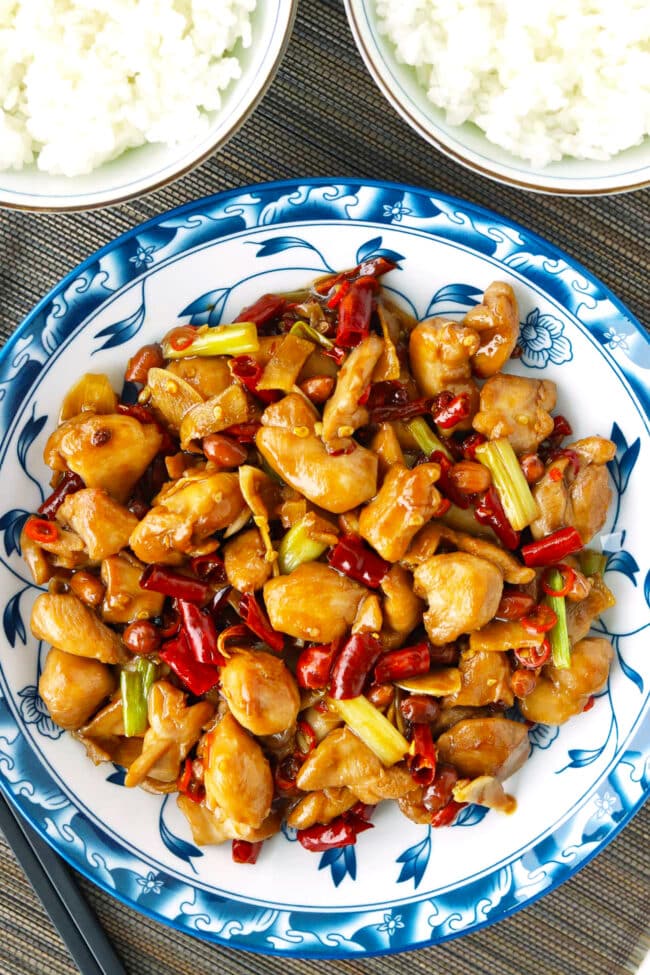
Why This Recipe Works
- Quick and easy! Everything gets quickly prepped and cooked in under 30 minutes!
- Expert techniques. Keeping things constantly moving in the wok over high heat prevents the meat from becoming mushy or drying out. It also helps the aromatics to retain their crispness and fragrant aromas.
- Perfectly tender and juicy chicken pieces. Cooking the chicken separately first before adding it back into the stir-fry allows the meat to take on the flavors of the marinade and prevents it from being overcooked.
- Even cooking. Cutting all the ingredients in to small pieces promotes quick and even cooking.
- Customizable spice level. Authentic kung pao chicken is infused with ma-la flavors from the numbing spice from Sichuan red peppercorns (ma – 麻) and hot dried Chinese red peppers (la – 辣). However, you can adjust the amount of these ingredients to suit your heat level preference.
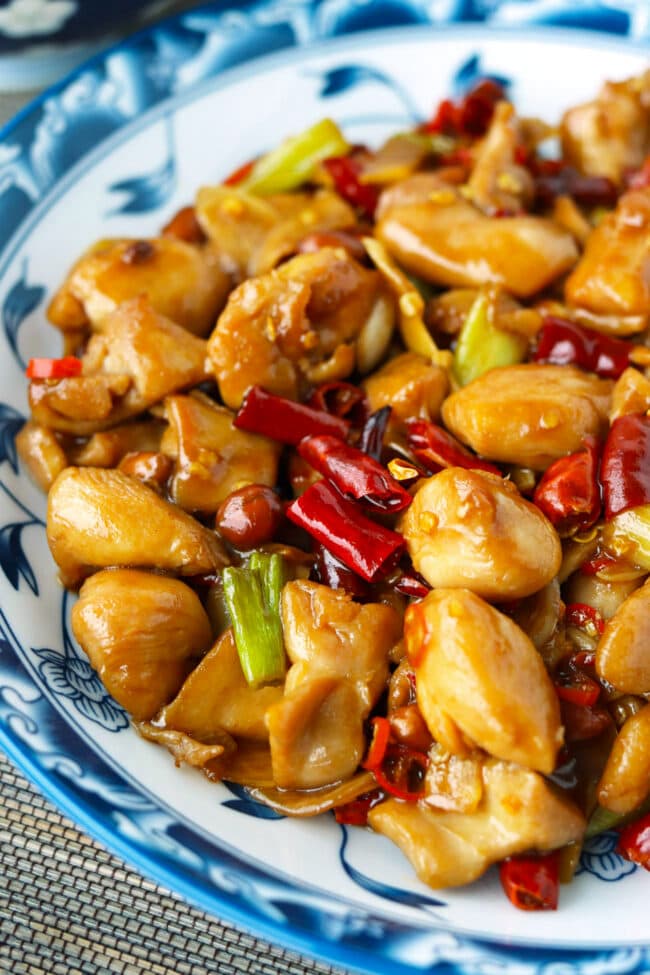
Ingredient Notes

- Chicken: I used diced boneless and skinless chicken thighs as they’re incredibly flavorful and tender in stir-fries (like my Spicy Pepper Chicken). That being said, boneless and skinless chicken breasts will work well too and won’t dry out in this recipe due to the quick stir-frying technique.
- Aromatics: The Chinese holy trinity – garlic, ginger, and spring onion (scallion/green onion). Only the white parts of the spring onion are needed. You can also use the white part of a Welsh onion or leek, which is commonly used in Chengdu-style kung pao chicken.
- Sichuan Red Peppercorns: These have a lovely citrusy numbing “spicy” flavor and are a key ingredient in an authentic kung pao chicken dish. They make your tongue tingle and buzz a little, but are not spicy hot. Find them in an Asian supermarket or order them online. In Asia, these are usually available in wet markets.
- Chinese Dried Red Chilies: I used Qiubei dried red chilies here which are medium-hot spicy. Feel free to use any dried red chilies that are easily available to you. Traditionally, lots of dried chilies are used in kung pao chicken to make it spicy. However, you can reduce the amount and even shake out the seeds after snipping them to make this dish milder. If you’re using Thai dried red chilies, use less as they are hotter than most Chinese dried red chilies. If you love your spicy food, Xiao Mi La Chilies (Chinese) and Jinda dried chilies (Thai) are excellent options and promise a powerful punch! Jinda chilies are wonderfully aromatic and fragrant, and can be used in several Thai recipes too. Note that the dried chilies are used to flavor the dish but not usually eaten.
- Fried Red-Skin Peanuts: An authentic kung pao chicken calls for unsalted fried red-skin peanuts to add nuttiness and crunch. They’re readily available at street shops in Hong Kong and China and in wet markets. If you’re based elsewhere, you can find try finding red-skin peanuts in Asian supermarkets and quickly fry them at home. I’ve included instructions in the notes section of the recipe card on how to fry the peanuts. Alternatively, you can substitute with unsalted dry roasted peanuts if you prefer. They work just as well to deliver the signature crunch in this dish. I use less peanuts than typically called for in this dish. Feel free to use more and up to ¾ cup if you like.
- Peanut Oil: Or use any neutral flavored oil with a high smoke point.
Optional Ingredients:
- Pure Chili Oil: I sometimes add a little pure chili oil (without seeds or flakes) to cook the stir-fry in addition to the peanut oil for extra heat. I usually do this only when the dried chilies I have on hand are not that spicy. However, this is completely optional and is not traditionally used in authentic kung pao chicken. Feel free to omit it.
- Fresh Red Chilies: For more heat, I added a few fresh Thai Bird’s Eye chilies even though only dried red chilies are traditionally used. You can omit them or use less or more based on your heat level preference.
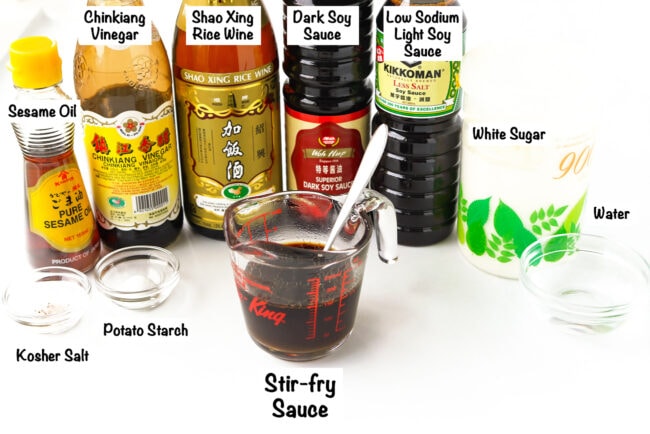
- Low Sodium Light Soy Sauce: So that we can control the salt level better in the chicken marinade and stir-fry sauce.
- Dark Soy Sauce: Chinese dark soy sauce is thicker than light soy sauce and used for mainly for color. You can use more low sodium light soy sauce in its place if you don’t have it on hand.
- Shao Xing Rice Wine: This Chinese cooking wine has a fragrant floral aroma and is an Asian pantry staple. We’ll use it for both the chicken marinade and in the stir-fry sauce. Look for it in an Asian supermarket or order it online. Dry sherry can be substituted if needed.
- Potato Starch: Just like corn starch, potato starch is commonly used in Chinese dishes for marinades to give the meat a silky coating and yield a tender and juicy texture once cooked. It’s also used in sauces as a thickening agent and for yielding a crispy exterior in deep-fried foods. You can use corn starch instead if it’s easier to find. But I like to use potato starch as feel the texture of the chicken is more tender once cooked. Bonus? Potato starch has less calories and carbohydrates than corn starch.
- Chinkiang Vinegar: This is a Chinese black vinegar and available in Asian and Chinese supermarkets. It adds a hint of tang and acidity to the kung pao sauce. If unavailable, substitute with half balsamic and half white vinegar to yield a similar flavor.
- White Sugar: To balance the spicy, salty, and tangy flavors. One tablespoon of sugar may sound like a lot, but after multiple rounds of testing, I believe it is needed to create the perfect balance of flavors. That said, feel free to use less or more based on your preference.
Full ingredient list and amounts are in the recipe card below.
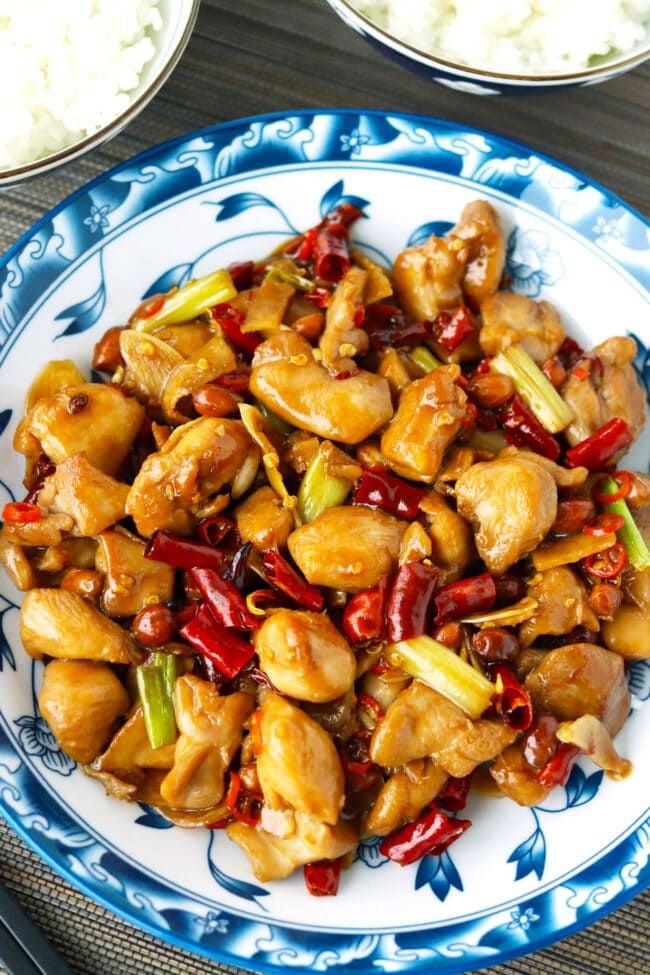
How to Make Authentic Kung Pao Chicken
Prep:
- Marinate the chicken. Cut the chicken into small cubes and combine with all the marinade ingredients in a bowl. Set aside to marinate for 15 minutes to let it absorb all the flavors and tenderize the meat.
- Make the kung pao sauce. Mix together all the stir-fry sauce ingredients in a measuring cup (makes it easier to pour into the wok) or bowl until combined well.
- Prepare the fresh ingredients. Thinly slice the garlic, ginger, red chilies (if using) and cut the spring onion white parts into small pieces. Snip the dried red chilies.
For the Kung Pao Chicken Stir-fry:
1. Cook the marinated chicken. Don’t fully cook it at this stage as it will finish cooking in the stir-fry later. Transfer to a clean bowl once 80% cooked.
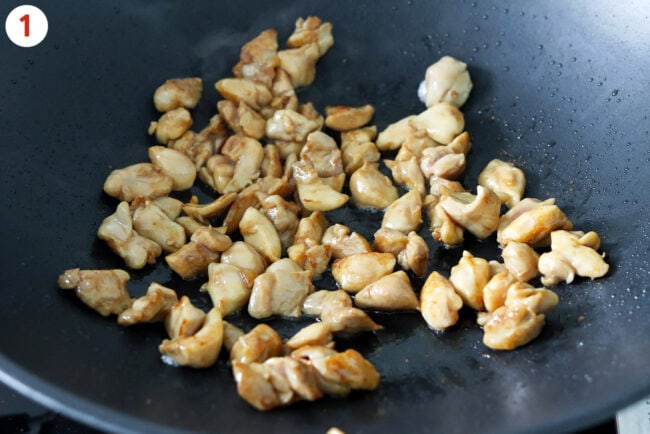
2. Stir-fry the aromatics. Stir-fry the garlic, ginger, and spring onion white parts until fragrant.
3. Add the spicy ingredients. Stir-fry the dried red chilies, Sichuan red peppercorns, and fresh red chilies for a few seconds to combine. Be careful to not let the dried red chilies and Sichuan peppercorns burn. They will become bitter if overcooked.
4. Add the chicken and kung pao sauce. Add the partially cooked chicken back into the wok and pour the sauce over everything. Toss to combine until everything is coated in the sauce and it thickens. If it starts to thicken too much, you can add a splash of water and continue tossing.
5. Toss through fried peanuts. Only for a few brief seconds to combine, then switch off the heat.
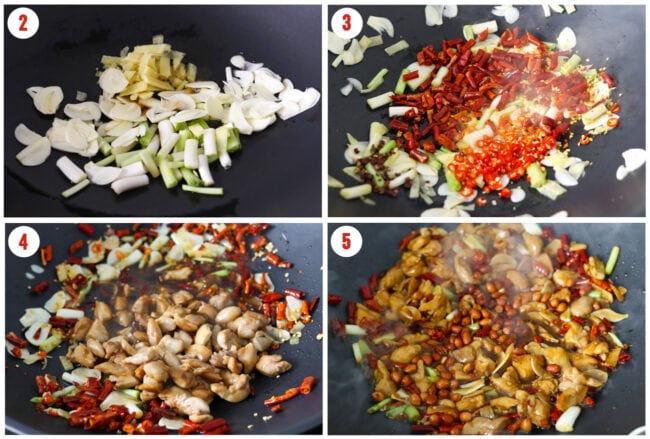
Serve! Transfer to a serving plate or dish and enjoy immediately with warm steamed rice!

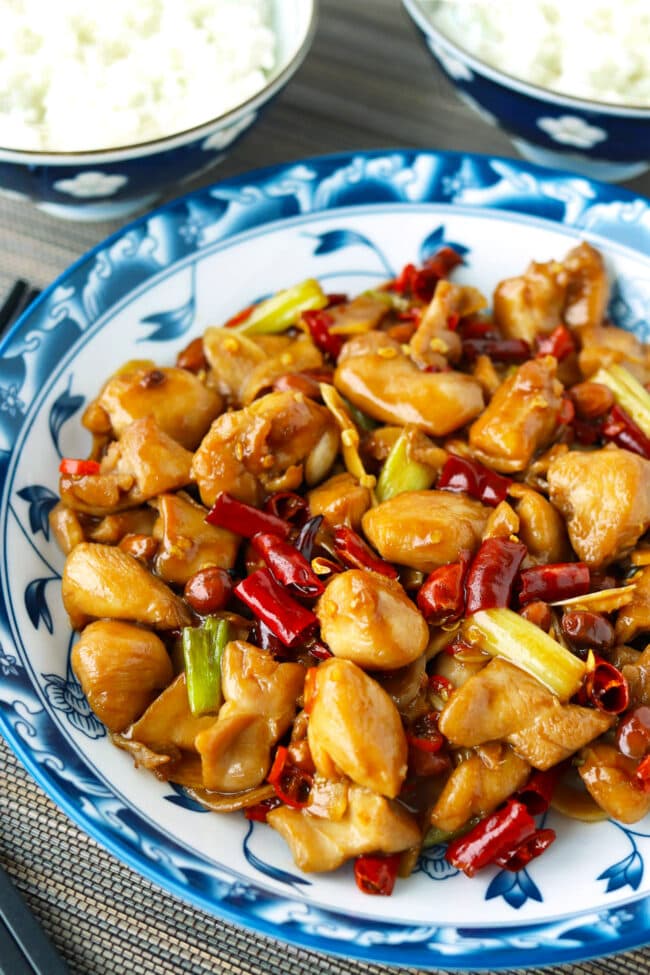
Full detailed instructions are in the recipe card below.
Cook’s Tips
- Remove the black seeds and twigs of the Sichuan red peppercorns. All the flavor is in the red husks. You don’t want to bite into any hard seeds or twigs while enjoying the dish.
- Cook over high heat and keep things constantly moving in the wok. This will ensure that nothing burns or gets overcooked. The sauce also won’t become gloopy.
- Cook in two batches if you need to double the recipe. If you try to double the recipe and cook everything in the same wok, the chicken will steam instead of fry and become mushy.
- Use a large heavy bottomed frying pan if you don’t own a wok. Nothing beats the wok hei (breath of the wok) flavor that comes from stir-frying in a cast iron wok. However, cooking over high heat in a heavy bottomed frying pan will still yield decent results in terms of flavors and textures as long as you don’t overcrowd it. I use a very large cold cast iron wok (46cm/18-inch) for this stir-fry.
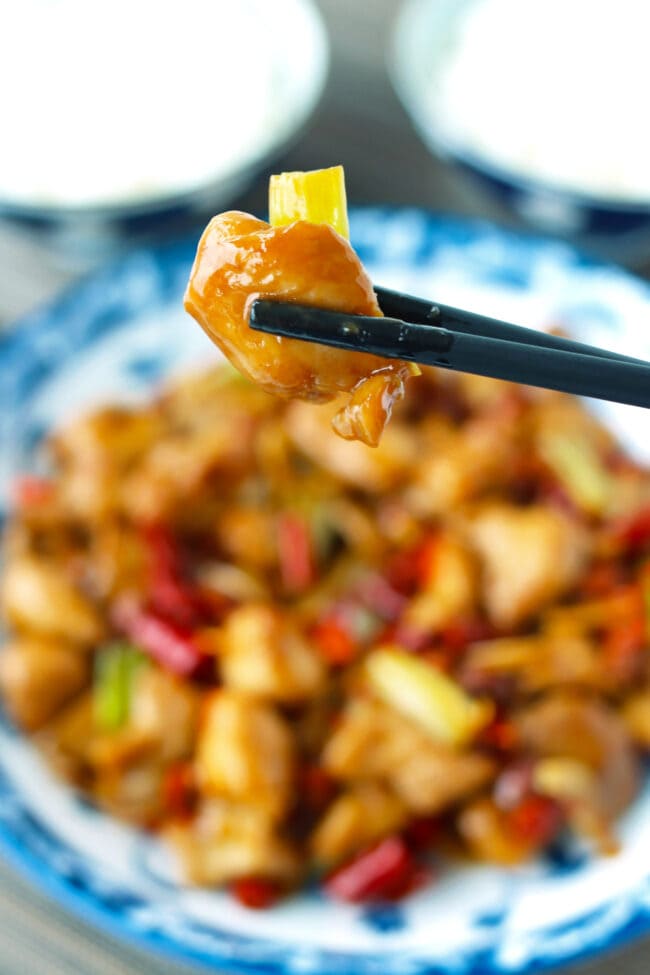
FAQs
Kung pao chicken is an amalgamation of savory, spicy, numbing, slightly sweet, tangy, and nutty flavors. Light and dark soy sauce offer savory notes, while dried red chilies and Sichuan red peppercorns deliver spicy flavors and a tongue-tingling numbing sensation. Chinese black vinegar adds a hint of tang and the addition of sugar balances out all these flavors so that none of the flavors are overbearing in this dish. Finally, fried peanuts add a crunchy texture and nuttiness to this stir-fry dish.
Sichuan dried red peppercorns and Chinese dried red chilies. Kung pao chicken has the signature ma (麻 – numbing) la (辣 – spicy) flavors that is commonly found in Sichuan dishes. The Sichuan red peppercorns give the dish a citrusy numbing (tongue tingling) spice flavor, while the hot dried red chilies give it the spicy heat factor. You can use less dried red chilies to make this dish milder.
Like many stir-fry dishes, the flavor and textures in this dish taste best right after cooking. It is not ideal to cook and store in the fridge for a later date. That being said, I have made this dish in the early evening and reheated in the microwave later for dinner. It still tastes great, but of course, not as great as it does when you eat it right after you finish stir-frying.

More Sichuan & Chinese Stir-fries
- Sichuan Dry Fried Green Beans
- Stir-fried Garlic Scapes with Pork & Tofu
- Pork and Wood Ear Mushroom Stir-fry
- Yu Xiang Qie Zi (Fish-fragrant Eggplant)
- Ants Climbing a Tree (Ma Yi Shang Shu)
- Or browse the entire Sichuan and Chinese Stir-fry recipe collections.
MADE THIS RECIPE? If you make this recipe, leave a comment below and let me know how you liked it! Take a photo and tag it with @thatspicychick on Instagram and hashtag it #thatspicychick and I’ll be sure to share your masterpiece!
STAY CONNECTED! You can also follow me on Pinterest, Facebook or Instagram. Sign up for my email list to get my latest recipe in your inbox weekly!
PrintAuthentic Kung Pao Chicken
Kung Pao Chicken is a popular Sichuan chicken stir-fry that’s quick and easy to make on any given weeknight and full of irresistible savory, spicy, numbing flavors with a hint of tang and crunchy peanuts. Make it at home the authentic Chengdu-style way!
- Prep Time: 10
- Cook Time: 15
- Total Time: 25 minutes
- Yield: 4 1x
- Category: Dinner
- Method: Stir-fry
- Cuisine: Sichuan
Ingredients
For the Chicken Marinade:
- 370 grams – 385 grams / 13 – 13.5 ounces Chicken Thighs (or Breasts), boneless, skinless – cleaned and pat-dried, cut into ¾-inch cubes
- 1 TBLS Low Sodium Light Soy Sauce
- 2 TSP Shao Xing Rice Wine
- ¼ + 1/8 TSP Kosher Salt (see notes*)
- 1.5 TSP Potato Starch (or Corn Starch)
- ½ TSP Sesame Oil
For the Sauce:
- 1 TSP Potato Starch (or Corn Starch)
- 1 TBLS White Sugar
- ¼ TSP Kosher Salt
- 2 TBLS Low Sodium Light Soy Sauce
- 2 TBLS Shao Xing Rice Wine
- 1 TBLS Chinkiang Vinegar
- ½ TSP Dark Soy Sauce
- 1 TSP Sesame Oil
- ¼ cup / 60ml Water
For the Kung Pao Chicken Stir-fry:
- 4 TBLS Peanut Oil (or any neutral flavored oil with a high smoke point)
- 1 TSP Pure Chili Oil (optional – without seeds/flakes)
- 1 TSP Sichuan Red Peppercorns – red husks only, black seeds and stems discarded
- 10–20 Chinese Dried Red Chilies (I used Qiubei dried red chilies – see notes*), to taste – stems removed, snipped into ½-inch pieces
- 6 Garlic cloves – thinly sliced
- 1.5-inch piece of Ginger – thinly sliced (about 2 tablespoons sliced)
- 5 Spring Onion (white and light green parts only – see notes*) – cut into ¾-inch pieces
- 1–3 fresh Red Chilies (optional – I used Thai Bird’s Eye chilies, but any small hot red chilies will work), to taste
- ¼ cup unsalted Fried Red-Skin Peanuts (or unsalted dry roasted peanuts – see notes*)
Instructions
Prep:
- Marinate the chicken: Clean and pat-dry the chicken thighs. Trim off excess fat if needed, then cut into ¾-inch cubes. In a medium bowl, combine the chicken, low sodium light soy sauce, Shao Xing rice wine, kosher salt, potato starch, and sesame oil. Mix until combined well, then set aside to marinate for at least 15 minutes.
- Make the sauce: Whisk together the potato starch, white sugar, low sodium light soy sauce, Shao Xing rice wine, Chinkiang vinegar, dark soy sauce, sesame oil, and ¼ cup water in a small measuring cup (or bowl) until combined well.
- Prepare the fresh/dry ingredients: Slice/cut the garlic, ginger, spring onion white and light green parts, fresh red chilies (if using), and dried Chinese red chilies as indicated in the ingredients section, then set aside.
For the Kung Pao Chicken Stir-fry:
- Cook the chicken: Heat 2 tablespoons peanut oil in a large wok over high heat. Once hot, add the marinated chicken and immediately spread the pieces out in the wok. Cook, undisturbed for 40 seconds, then stir-fry for 1 minute or until no longer pink and the chicken is 80% cooked through. Transfer to a fine mesh strainer and hold it above the wok to let the excess oil drip into the wok. Tip the chicken pieces into a clean bowl and set aside. Wipe out the wok with paper towels.
- Stir-fry aromatics: Heat the remainder 2 tablespoons peanut oil and 1 teaspoon chili oil (if using) over high heat. Once hot, add the garlic, ginger, and spring onion white and light green parts. Stir-fry for 30 seconds until fragrant.
- Stir-fry chilies and Sichuan red peppercorns: Add the fresh red chilies, dried red chilies, and Sichuan red peppercorns. Stir-fry for 15 seconds to combine, taking care to not let the dried red chilies burn.
- Add the chicken and sauce: Give the sauce a quick stir with a spoon (the potato starch will have settled at the bottom) to loosen it up. Add the chicken back into the wok and pour the sauce on top of everything. Toss for a minute until everything is evenly coated in the sauce. If the sauce starts to get too thick, add a tablespoon of water and continue tossing to combine.
- Toss through peanuts: Add the fried peanuts and toss briefly to combine, then switch off the heat.
- To Serve: Transfer to a serving plate/dish and serve immediately with warm steamed rice.
Notes
- Asian pantry sauces. Shao Xing rice wine (Chinese cooking wine), Chinkiang vinegar (Chinese black vinegar), and dark soy sauce (thicker than light soy sauce and used for color mainly) can all be found in an Asian supermarket, some mainstream supermarkets that is well-stocked with international ingredients, and online. Substitute dry sherry for Shao Xing rice wine, half white and half balsamic vinegar for Chinkiang vinegar, and low sodium light soy sauce for dark soy sauce if unavailable.
- Kosher salt. Use a little less than half the amount if using iodized table salt.
- Spring onion. You can use the white parts of a Welsh onion (commonly used in Chengdu style kung pao chicken in Sichuan and Hunan restaurants) or leek instead if you like. To prepare them, cut the white parts into ¾-inch pieces and discard the top green parts (or save for another time). If using the white part of a leek, soak in a bowl filled with water after cutting to get rid of any excess dirt for 10 minutes. Rinse and drain, then pat-dry with paper towels before using in the stir-fry.
- Chinese dried red chilies. I used Qiubei dried red chilies here which are medium spicy. Use any dried red chilies that are easily available to you. Feel free to reduce the amount and even shake out some of the seeds after snipping them to make this dish milder. If using Thai dried red chilies, use less as they are hotter than most Chinese dried red chilies. If you love your spicy food, Xiao Mi La Chilies (Chinese) and Jinda dried chilies (Thai) are excellent options and promise a powerful punch! Note that the dried chilies are used to flavor the dish but not usually eaten.
- Sichuan Red Peppercorns. These have a citrusy numbing “spicy” flavor and are a key ingredient. They make your tongue tingle and buzz a little, but are not spicy hot. Find them in an Asian supermarket or order them online. In Asia, these are usually available in wet markets.
- Fried red-skin peanuts. Look for these in an Asian supermarket. If you can only find raw red-skin peanuts, you can easily and quickly fry them at home. To do so, heat ¼ cup peanut or other neutral oil in a wok or small saucepot over medium-high heat. Once hot, add ½ cup of red-skin peanuts and turn the heat down to medium-low. Fry, stirring gently, until the skins of the peanuts are a deep shade of reddish-brown. This should take about 3-5 minutes. Use a slotted spoon to transfer to a paper towel lined plate to drain. Then spread the peanuts out on a sheet of parchment paper and allow to cool for 30 minutes. Store in a sealed airtight container in a cool dry area and use within 1 week. You can strain the oil and use it to cook the kung pao chicken stir-fry.
Nutrition
- Serving Size: 1 serving
- Calories: 305
- Sugar: 4.5g
- Sodium: 706.6mg
- Fat: 18.5g
- Saturated Fat: 3.2g
- Unsaturated Fat: 13.6g
- Trans Fat: 0g
- Carbohydrates: 13.7g
- Fiber: 2.2g
- Protein: 22.9g
- Cholesterol: 86.9mg
This post may contain affiliate links. We are a part of the Amazon Services LLC Associates Program, an affiliate advertising program designed to provide a means for us to earn a small commission (at no extra cost to you) by linking to Amazon.com and affiliated sites. The nutritional information provided is approximate and can vary based on several factors. It should only be used as a general guideline. For more information, please see our Disclosure.



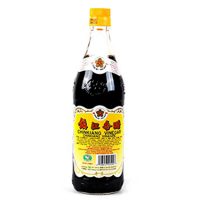
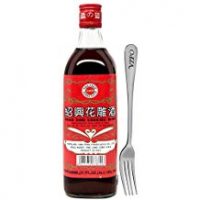
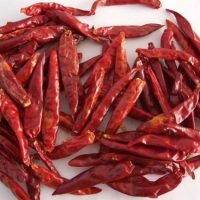


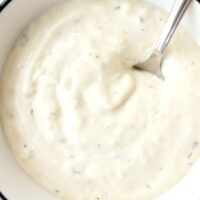
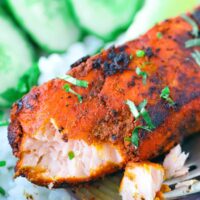
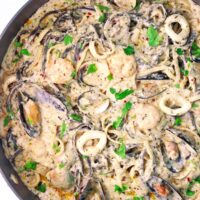

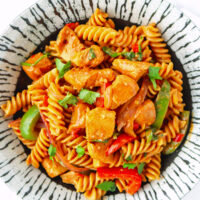
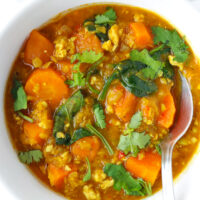

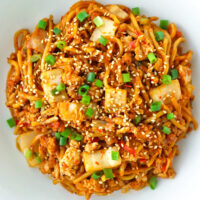
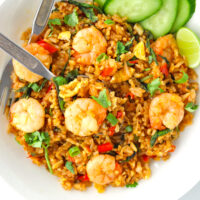
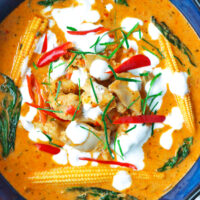

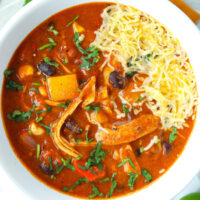
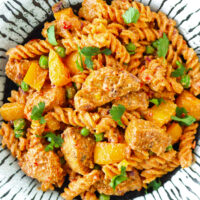
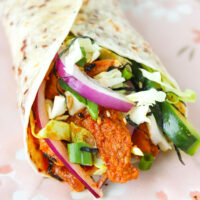

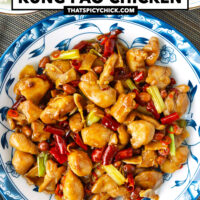
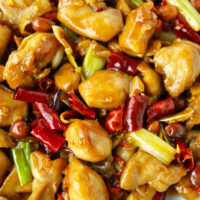
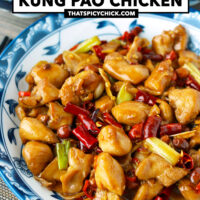


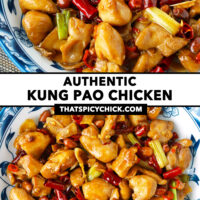

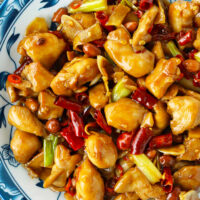

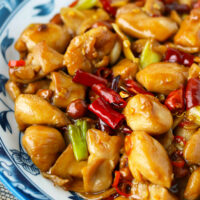

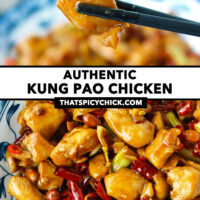

Kung pao chicken is my favourite dish, and I’ve tried plenty of recipes. This honestly is the closest I’ve found to Chinese restaurant-style KPC. It turned out excellent. Thanks Lavina!
Thank you, MJ! Glad you enjoyed this recipe!